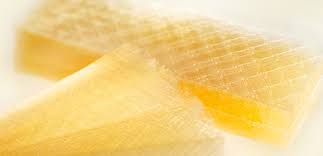
Made from 100% organic pig skin from organic farming in the EU.
Gelatine can be added to a balanced diet to enhance protein content.
Gelatine can be dissolved in hot food, where it is barely noticeable by taste, and only becomes apparent when the food goes cold, and it thickens.
Details Click to see more
Organic gelatine sheets can be used in all your recipes calling for gelatine.
Gelatine Usage Guide
Gelatine sets firm when cold and melts completely at 35 degrees centigrade.
1 sheet of organic gelatine to 100ml liquid = soft set (easy to turn out)
1 sheet of organic gelatine for 125ml liquid = wobbly soft set (served in a container)
How to Use Orgnaic Gelatine Sheets
Leaf gelatine must be soaked before use, usually for aprrox 5 minutes in cold water. Soak in a suitable container so the leaves do not stick together.
Once soaked, remove the gelatine and squeeze to remove excess moisture.
Gelatine can now be melted in the warm liquid that you would like to set. This liquid must be over 35 degrees centigrade.
The gelled liquid will set once it has cooled below 4 degrees centigrade.
The Effect of Commonly Used Ingredients on the Setting Point of Gelatine
Salt lowers the strength and can cause collapse of the structure or even prevent setting. To counteract this, try using more gelatine.
Milk and dairy products strengthen the gelling process.
Sugars increase the strength of gelling, with the exception of fruit sugars. Acids such as vinegar, fruit juice and wine with a pH below 4 produce a weaker jelly and require the amount of gelatine to be increase by up to 1/3.
Strong acids and tannins, like in wine, can make a jelly cloudy. To avoid this, try cooking a tannin rich liquid with the gelatine solution for a minute or two. Also, try passing the jelly through a muslin cloth.
Pineapple, papaya, melon and kiwi fruit all contain protein digesting enzymes that break down gelatine. These enzymes can be deactivated by cooking the fruits/juice.
Do not leave gelatine in soaking water for too long, as it will start to break down, and will not be as strong.
Approximate Conversions for Powder Gelatine to Leaf Gelatine 1 level teaspoon of powder = 1.5 leaves approx.

